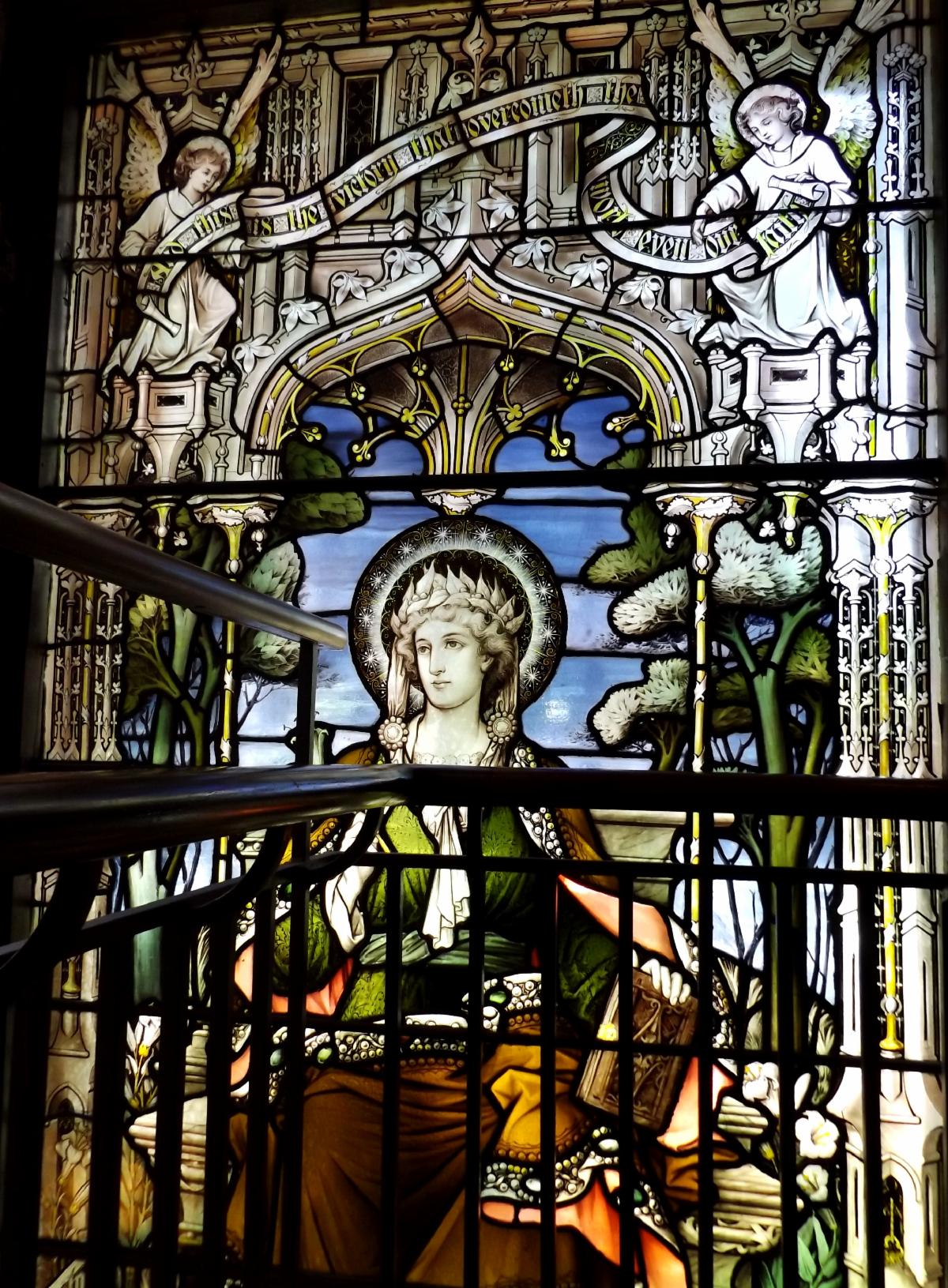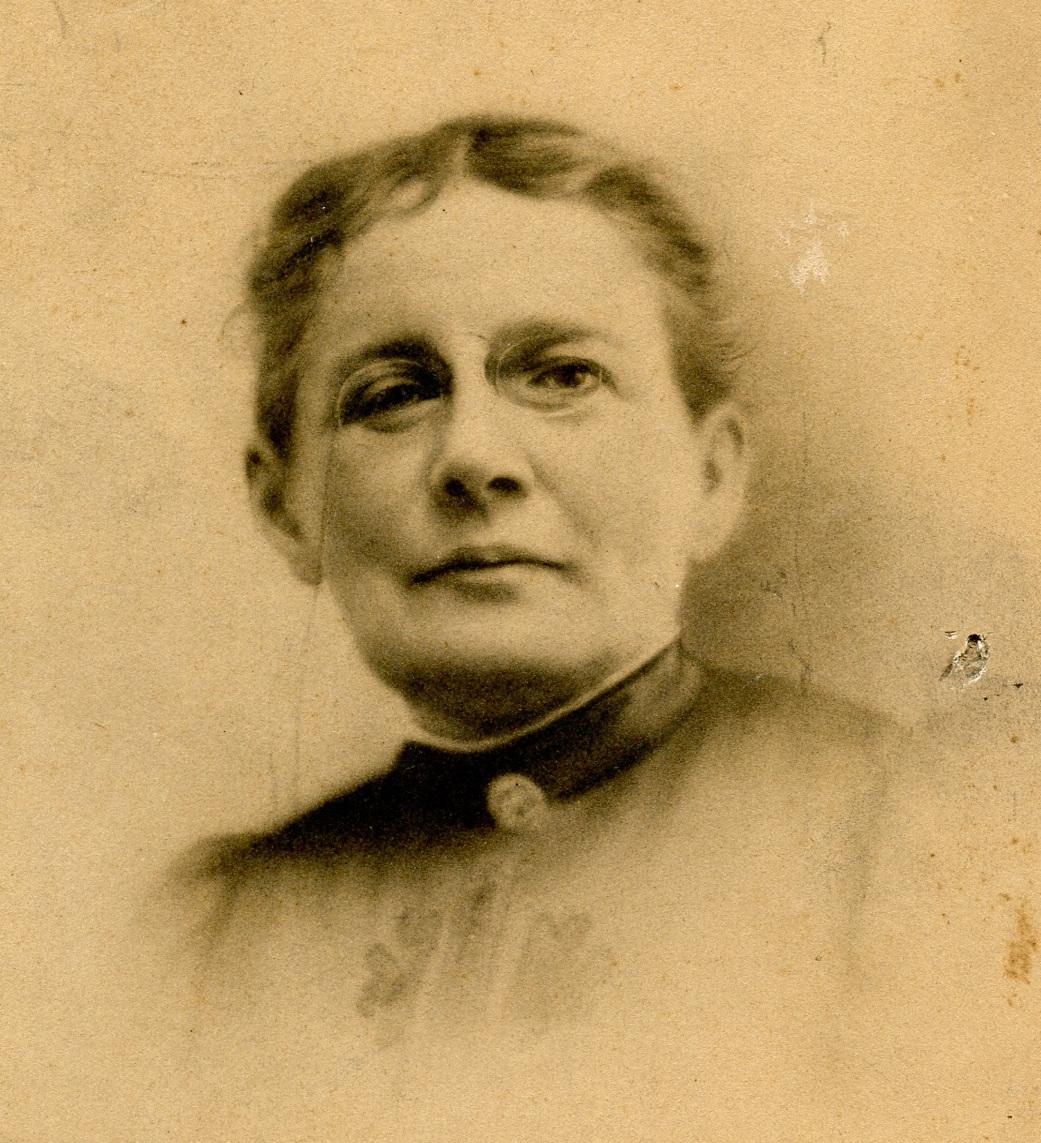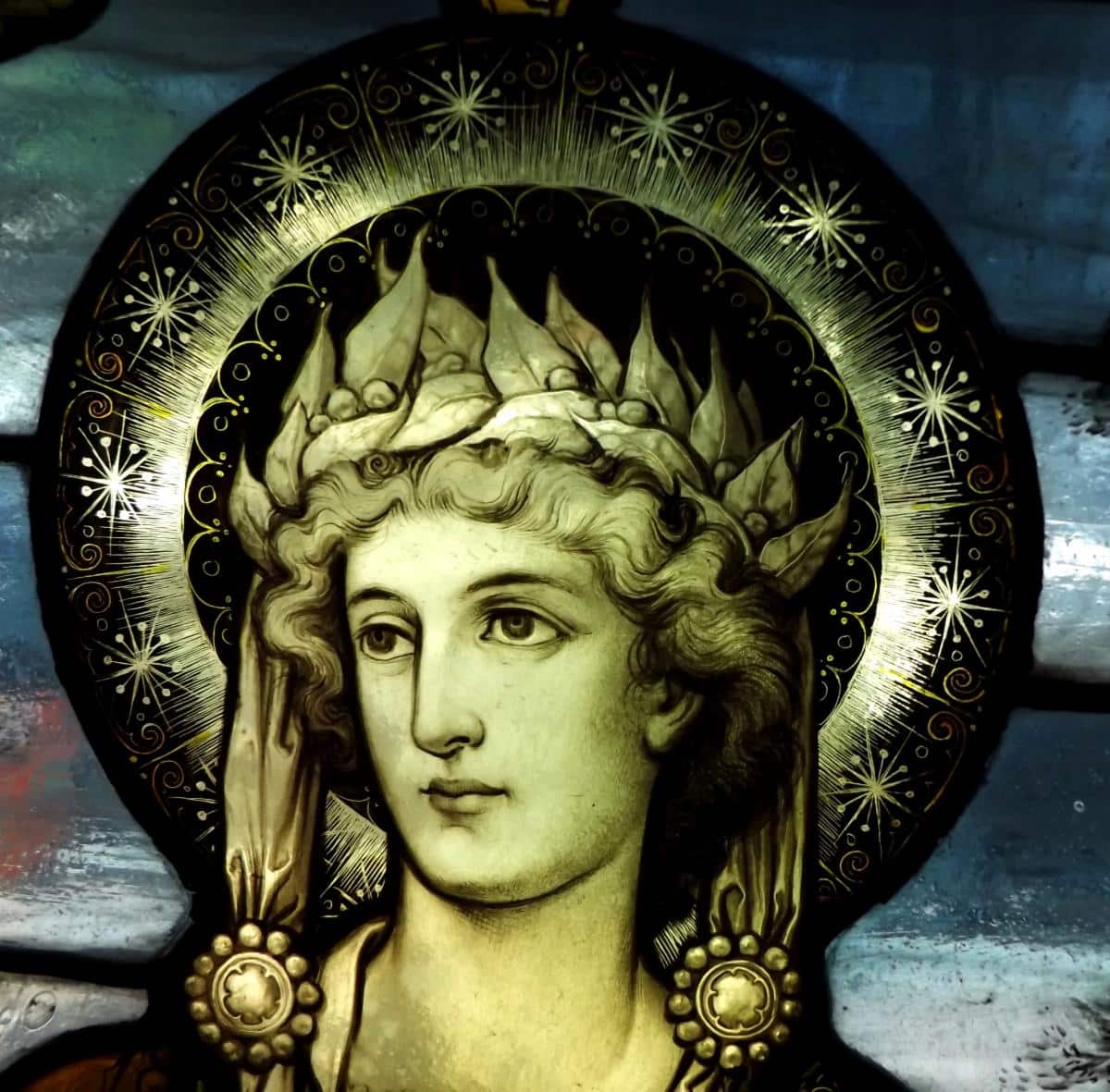Dear Trinity Church and friends,
The next time you enter the Parish House, make your way past the front desk toward the east stairwell, and then pause. Take a moment to look up. Way up. There you will see “The Woods Window,” commissioned in memory of Lucy Rice Woods by her Women’s Bible Study Class, a class she taught at Trinity Church for 33 years.
The window was installed in 1906 in what was then known as the parish library of Trinity Chapel. The window was executed by John Hardman and Company, Birmingham, England, and designed by Dunstan John Powell, grandson of noted English architect and artist Augustus Pugin. As described in the Boston Evening Transcript, “Most of the window is taken up with a large figure of a woman enthroned, and is symbolic of the victory of a blameless life. On one side is the word “Purity,” and on the other “Prayer.” Underneath is the inscription, “This is the victory that overcometh the world, even our faith.”
In that same year, at St. Matthew’s Church in Fairbanks, Alaska, worshippers witnessed the installation on the altar of a solid brass cross, surmounting three brass steps and standing forty inches in height. It was a gift from the Massachusetts Woman’s Auxiliary. Upon it is inscribed, “To the Glory of God in Loving Memory of Lucy Rice Woods.”


So, who was Lucy Rice Woods?
Lucy Rice Woods was born on Christmas Day in 1847 to George A. Woods and Margaret D. Loring. When her mother died three years later and her father a few years after that, young Lucy was sent to live with the family of her mother’s twin sister. When she was six, Lucy contracted an illness that “cast a shadow on her childhood,” friend Florence Dix later recalled.
“Until she reached her eighteenth year, she was at times under this shadow, suffering finally from trouble with her eyes that left them near-sighted. But the buoyant spirit and clear intellect were not to be crushed by mortal ills. In the intervals of health and freedom from pain, she was the leader in everything.”
Indeed, despite her health, in school and throughout her life, she was an illuminating figure in the lives of those around her.
“Her hair, gathered in bright curls on her shoulders, her vivid face with its sensitive color coming and going, her slender, expressive hands, her quick movements, her joyous, laughing voice, the hint of physical defect that put the touch of pathos to all her marvelous achievements – all these made her a marked personality, a fascinating presence.”
She excelled in her studies and went on to become a teacher at her alma mater Girls’ High School in Boston, where she would teach for more than three decades. Teaching was her calling. At Trinity she founded a Women’s Bible Study Class.
A Miss Ellicot later recalled, “Mr. Brooks came to Trinity in 1869 and in 1870 Miss Woods went to him and said she would like to take a class in the Sunday School. He said he was sorry there was no class for her, but the number of teachers was sufficient. “Oh,” said she, “I will bring my own class” and did. I joined the class in 1875. We outgrew I don’t know how many rooms. There were from thirty to seventy girls, colored and white, rich and poor, girls who came from the West to study for a while and were commended to Mr. Brooks, who would take them to Miss Woods.” For 33 years she taught girls in the mornings while Sarah Wyman Whitman taught women in an evening class.By all accounts, she and Phillips Brooks developed an abiding friendship. At the end of her life, Brooks’s assistant Reverend F. B. Allen, recalled, “Where many who more nearly equaled him in stature were overcome with awe in his noble presence, she met him as an intellectual equal, and in the play of argument was recognized by him as his spiritual peer. In soul proportions they were comrades.”In remembering Woods, Louis R. Taylor wrote, “For many years two kindred spirits, close friends, worked together in Trinity Church, the famous preacher, Phillips Brooks, and the teacher, Miss Woods. One striking resemblance in the faces of those two comes back to me today, the divine light which shone out, when, lifted above the things of this world, they spoke to us of heavenly things until they were transfigured before us.”Woods and Brooks would remain friends until Brooks’s unexpected death in 1893. In a letter to her dated December 13, 1892, Brooks wrote, “It has been a great privilege to have your friendship all these years. To begin another year with this pleasant assurance that I have it still is very good …”In addition to teaching the Bible study class at Trinity, Woods joined the Massachusetts Branch of the Women’s Auxiliary to the Board of Missions, organized 1877. The Women’s Auxiliary to the Board of Missions, now known as the Episcopal Church Women (ECW), was a fellowship and mission organization promoting education, health care, and relief from poverty. Woodsalso served as committee chair of the Indian and Colored Peoples’ Mission. In 1884 Woodsbecame an Associate of the Girls’ Friendly Society and served for nine years as a member of the Society’s Diocesan Council.

Though Woods shied from attention, her good works and the gifts she gave to all, especially young women, were well-known and greatly respected. The Boston Herald noted in 1895 that her Bible study class numbered more than 50 young women. She was applauded as “a teacher of influence” and that the qualities that contributed to her success at Girls’ High School were being amply applied at Trinity Church.
On March 24, 1904, Lucy Rice Woods died in her home at 42 Newbury Street. She’d been seriously ill for at least three weeks prior. Upon her death, one admirer noted,
“… a nimble wit and felicity of phrase lent to her animated speech an irresistible charm, beguiling all hearer. Faithful to every duty, fearless in truth, pure and single-hearted in aim, loyal in friendship, kindling and kindled by love, hers was a life that dared to send a challenge to its end; and when that end came she looked with dimmed but unwavering gaze towards it, able to say with steady and cheerful voice, “Welcome, friend,” and so went calmly and trustingly out into the unknown.”
Eight hundred students from the Girls’ High School and Latin School attended her funeral. An obituary in the Boston Evening Transcript noted, “At no such service since the day Phillips Brooks lay there, when this day was laid his old-time co-worker and valued friend, has such a multitude assembled to honor a woman unknown to fame, yet whose name was writ large on the heart of everyone present.”
Until next month,
Cynthia
Sources and Further Reading
Briggs, Elsie Prentiss. A Preliminary Study about Phillips Brooks and Lucy Rice Woods. Presented to the Saturday Morning Club, January 6, 1979.
Funeral of Miss Lucy Rice Woods. Boston Globe March 27, 1904, p.7.
Girls’ Friendly Society – https://www.gfsus.org/
Lucy Rice Woods. Boston Evening Transcript March 30, 1904, p. 9.
Memorial Window in Trinity Church Boston. The Churchman. January 27, 1906. p. 22.
National Episcopal Church Women – https://ecwnational.org/resources/about/
New Altar Cross. Beautiful Emblem is Presented to St. Matthew’s Church in Memoriam of LucyRice Woods. Fairbanks Evening News October 15, 1906, p. 1.
New Window in Trinity Church. Boston Evening Transcript Friday January 5, 1906, p. 6.
Not Death, But Consecration. Boston Evening Transcript Monday March 28, 1904, p. 10.
Recent Deaths. The School Journal Volume 68, April 2, 1904, p. 407.
The Children’s Cottage Hospital. Boston Evening Transcript Wednesday December 16, 1885, p. 6.
Woods, Lucy R. A History of the Girls’ High School of Boston 1852-1902. Riverside Press, 1904. https://ia902807.us.archive.org/19/items/historyofgirlshi00wood/historyofgirlshi00wood.pdf
Photo of Lucy R. Woods, circa 1877, courtesy of Trinity Church Archives.

